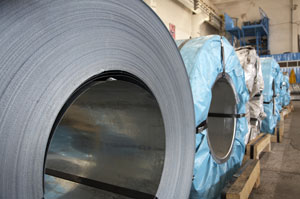Precision Ultrasonic Gauging - Metals
Ultrasonic thickness gauges can be used to measure a wide variety of forged, rolled, machined, cast, or extruded metal products over a thickness range from about 0.2 mm (0.008 in.) up to 500 mm (20 in.) depending on the grain structure.

What Metals Can Be Measured Using Ultrasonic Gauges?
Some common examples of metals that can be measured are listed below.
Pipes and tanks: There is corrosion measurement involving metal pipes and tanks, but precision thickness measurement during the manufacturing process is also possible.
Sheets and coils: Metal sheet and coil stock can normally be measured to very high accuracy at any point where the operator has access to one side of the material. Ultrasonic gauging is especially useful for wide products that are difficult to measure with mechanical gauges except at the edges.
Automotive sheet metal: The complex shape and large size of many automotive sheet metal fabrications can make mechanical measurement challenging, but ultrasonic gauging can be performed at any point where there is access to one side, including reduction rate measurement at bends.
Small-diameter tubing: Wall thickness and concentricity of precision metal tubing as small as 2 mm or 0.080 in. in diameter can be measured using focused transducers.
Gun drilling: Drill drift during gun drilling operations can result in holes whose position varies with depth. An ultrasonic gauge can locate and measure the depth of holes from the outside surface at any point along the length of a part.
Castings: Wall thickness of hollow ferrous and nonferrous castings can be measured ultrasonically, even those with complex shapes like engine blocks. Ultrasonic gauges can also be used to check nodularity in cast iron.
Turbine blades: The wall thickness of hollow turbine blades for aircraft engines and similar critical applications can be measured with small focused transducers, both to detect core shift during manufacturing and to gauge wear in service.
Machined parts: During machining operations, sometimes inspectors need to check the wall thickness of parts to ensure that they are within specification. Ultrasonic gauges are helpful tools for this application when the inside surface of the part is difficult or impossible to reach.
For more information on precision ultrasonic gauging of other materials, see our guide on using ultrasonic thickness gauges to measure plastics or glass and ceramics.